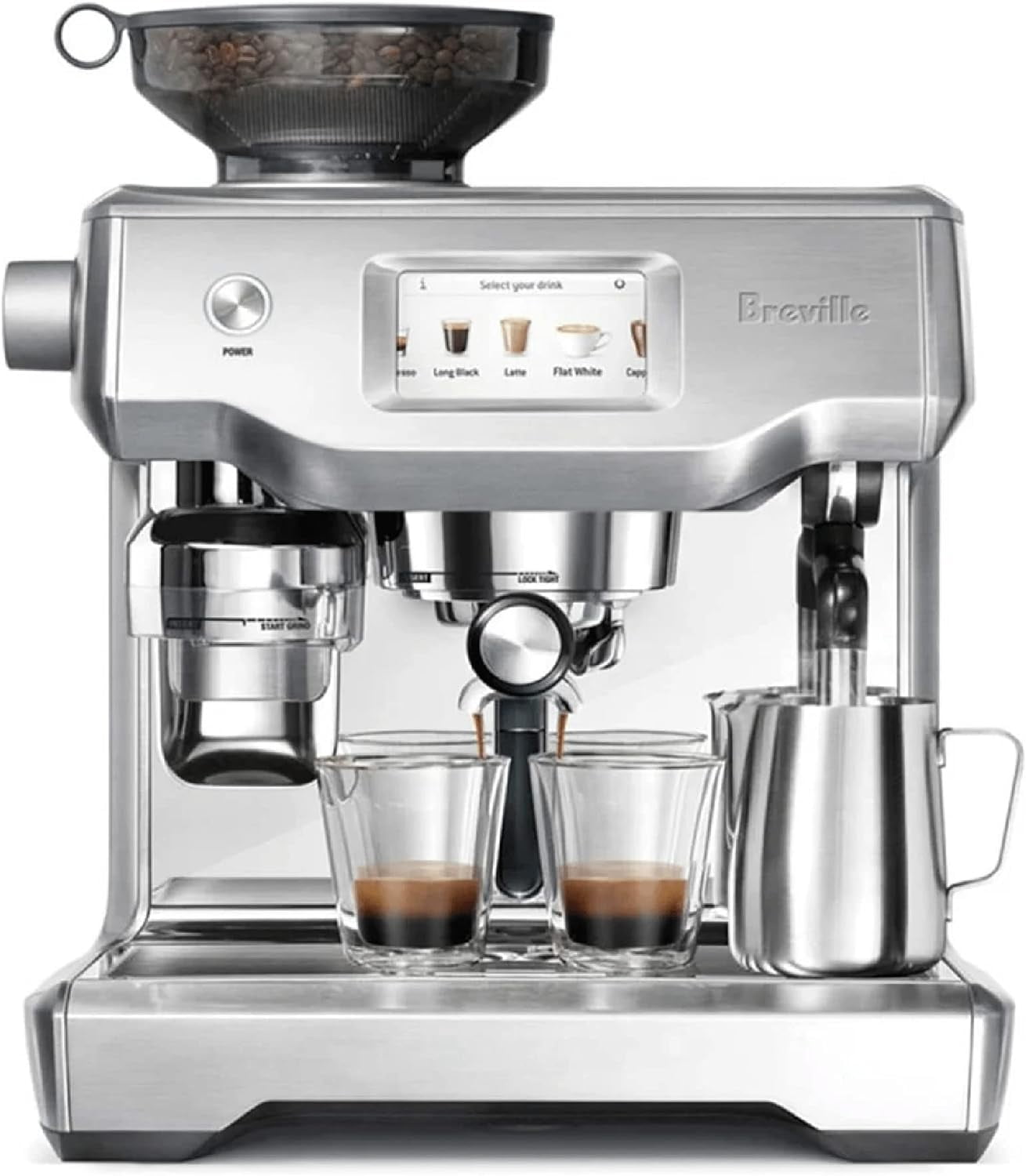#1: Breville Oracle
- Dual boiler system for simultaneous brewing and steaming
- Automatic grinding, dosing, and tamping
- Precise temperature control for consistent espresso
#2: Breville Oracle Touch

- Touchscreen for easy, customizable drink selection.
- Automated milk texturing for perfect froth.
- Fully automatic espresso process with user-friendly interface.
As a coffee enthusiast, I’ve spent countless hours researching and experimenting with various espresso machines. Recently, I found myself debating between the Breville Oracle and the Oracle Touch. Both machines promise exceptional performance, but which one truly stands out? After extensive exploration and hands-on experience, I’m ready to share my insights on the Breville Oracle vs Oracle Touch.
Before diving into the details of each machine, let me share a bit of my journey with espresso. My first experience with brewing coffee at home was with a basic drip machine, which quickly left me yearning for more flavor and control. As I delved into the world of espresso, I learned that the quality of the machine could drastically alter the taste of my morning cup. That’s when I discovered the Breville Oracle, which piqued my interest due to its reputation for balancing automation with the nuances of traditional espresso making.
After using the Oracle for several months, I was thrilled when the Oracle Touch was introduced. The promise of an intuitive touchscreen and more automated features had me curious about whether it could enhance my coffee experience or if the original would still reign supreme.


Understanding the Breville Oracle
The Breville Oracle has established itself as a powerhouse in the espresso machine market. It combines the artistry of traditional espresso-making with automated features, making it perfect for both beginners and seasoned baristas. One of the standout features of the Oracle is its dual boiler system, which allows for simultaneous brewing and steaming. This feature not only saves time but also ensures that the espresso is brewed at the optimal temperature while the milk is frothed to perfection.
In my experience, the dual boiler system has been a game changer during busy mornings. I can brew a rich shot of espresso while simultaneously frothing milk for a cappuccino or latte, significantly speeding up my coffee-making process. The ability to have both functions working together means I can prepare multiple drinks for myself and family without the frustrating wait time associated with single boiler machines.
The Convenience of the Oracle Touch
On the other hand, we have the Breville Oracle Touch, which builds upon the foundation laid by the Oracle. The standout feature of the Oracle Touch is its intuitive touchscreen interface. This modern touch panel allows users to easily select and customize their drinks. From lattes to cappuccinos, the Oracle Touch offers pre-programmed settings that cater to various coffee styles, making it incredibly user-friendly.
One afternoon, I had friends over, and they were curious about making their own lattes. I set up the Oracle Touch, and they were impressed by how simple it was to choose their desired drink and adjust settings on the touchscreen. The automatic milk texturing made it easy for them to achieve the perfect froth, which took away the intimidation factor often associated with making espresso drinks.
Comparing the Key Features: Breville Oracle vs Oracle Touch
When diving into the specifics of the Breville Oracle vs Oracle Touch, several features stand out that can influence your decision:
1. Brewing and Steaming Efficiency
In terms of brewing efficiency, the Breville Oracle takes the lead. Its dual boiler system allows for continuous brewing and steaming, which is a significant advantage for those who often entertain guests or simply enjoy making multiple drinks in one go. The Oracle Touch, while efficient, requires a moment for the machine to switch between brewing and steaming, which can be a minor inconvenience during busy mornings.
During my typical weekend mornings, I often whip up several drinks for family or friends. The Breville Oracle's efficiency shines during these times, allowing me to create drinks in quick succession without compromising on quality.
2. Customization Options
While the Oracle Touch excels in user-friendliness with its touchscreen controls, the Breville Oracle provides a more hands-on approach to customization. For those who enjoy fine-tuning their coffee experience, the Oracle offers precise control over grind size, dose, and temperature settings. This level of customization can lead to discovering the perfect brew that aligns with personal taste preferences.
One of my favorite aspects of the Oracle is the ability to tweak the grind size and dose to match the specific beans I’m using. I often purchase fresh, single-origin beans, and adjusting these settings allows me to fully explore their flavor profiles, which is an enjoyable and rewarding process.
3. Grinder Quality and Freshness
Both machines feature integrated grinders, but the Breville Oracle's grinder is designed with a focus on achieving uniform grind consistency. This consistency is crucial for optimal extraction and flavor. The Oracle Touch also features a grinder, but some users have noted that it may not achieve the same level of grind quality as its predecessor. This difference can impact the overall flavor profile of your espresso.
I’ve found that the grinder on the Breville Oracle produces a finer, more consistent grind, which noticeably improves the quality of my espresso shots. It’s something I’ve come to appreciate, especially when I experiment with different bean types that require specific grind settings for optimal extraction.
User Experience: Which One is Better?
Having spent time using both machines, I can confidently say that my preference leans towards the Breville Oracle. While the Oracle Touch offers advanced features and user-friendly controls, I found that the Oracle’s emphasis on manual control and customization resonates more with my coffee-making style.
The tactile experience of adjusting the grind size, temperature, and milk frothing techniques gives me a sense of connection to the brewing process that I simply don’t get with the Oracle Touch. It feels like an art form, and I appreciate the skill involved in crafting the perfect cup of coffee.
4. Milk Frothing Technology
Milk frothing is an essential part of creating high-quality espresso drinks, and both machines excel in this category. However, the Breville Oracle allows for greater manual control, enabling users to experiment with different frothing techniques. This is particularly appealing for those who wish to master their latte art skills. The Oracle Touch’s automatic frothing is convenient, but it may limit the creative possibilities for passionate coffee drinkers.
After getting the hang of the manual frothing technique with the Oracle, I found that I could create beautifully textured milk for my drinks. I enjoy taking my time to perfect the foam, which has made my at-home coffee experience more fulfilling.
The Verdict: Breville Oracle vs Oracle Touch
In my opinion, the choice between the Breville Oracle and the Oracle Touch ultimately comes down to what you value most in your coffee-making experience. If you’re someone who enjoys the art of brewing and values customization, the Breville Oracle is the better option. It gives you a deeper connection to the process, allowing for greater experimentation and mastery.
On the other hand, if convenience and ease of use are paramount, particularly for casual coffee drinkers or those new to espresso, the Oracle Touch might be more appealing. Its intuitive design makes it accessible and user-friendly, perfect for those who want to enjoy quality coffee without the complexity.


Product Review Conclusion: Breville Oracle vs Oracle Touch
In the debate of Breville Oracle vs Oracle Touch, the Breville Oracle emerges as the superior choice for serious coffee enthusiasts. Its combination of dual boiler efficiency, customizable settings, and high-quality grinder creates an unparalleled brewing experience. While the Oracle Touch is an excellent machine in its own right, offering convenience and modern features, it lacks the hands-on engagement that many coffee lovers crave.
For those who want to explore the full potential of espresso-making and appreciate the artistry involved, the Breville Oracle is the clear winner. It not only delivers exceptional coffee but also enriches the brewing experience. If you're serious about your coffee and want a machine that provides both quality and customization, I highly recommend investing in the Breville Oracle.
Frequently Asked Questions
1. What are the main differences between the Breville Oracle and Oracle Touch?
The main differences lie in their operation and features. The Breville Oracle features a dual boiler system for simultaneous brewing and steaming, while the Oracle Touch has a touchscreen interface with pre-programmed settings for various drinks. The Oracle allows for more manual customization, whereas the Oracle Touch focuses on convenience with automatic milk frothing and easier drink selection.
2. Is the Breville Oracle suitable for beginners?
Yes, the Breville Oracle is beginner-friendly due to its automated features. While it offers manual controls for those who wish to learn more about the brewing process, the machine's automation helps beginners achieve good results without extensive experience.
3. Can I make lattes and cappuccinos with both machines?
Absolutely! Both the Breville Oracle and Oracle Touch are capable of making a wide range of espresso-based drinks, including lattes and cappuccinos. The Oracle provides more control over the frothing process, while the Oracle Touch simplifies it with its automatic settings.
4. How do the grinders on each machine compare?
The Breville Oracle features a high-quality conical burr grinder that offers consistent grind size and quality, which is essential for optimal flavor extraction. The Oracle Touch also has a grinder, but some users report that it may not achieve the same level of consistency as the Oracle’s grinder.
5. Which machine is easier to clean?
Both machines have removable components that make cleaning straightforward. However, the Oracle Touch may have a slight edge in ease of cleaning due to its simpler design and automated features. Regular maintenance, such as descaling and cleaning the milk frothing system, is important for both machines to ensure longevity.
6. Can I customize the coffee strength and temperature on both machines?
Yes, both the Breville Oracle and Oracle Touch allow for customization of coffee strength and temperature. The Oracle provides more granular control, allowing users to fine-tune their settings, while the Oracle Touch offers simplified adjustments via its touchscreen.
7. What is the price difference between the Breville Oracle and Oracle Touch?
The Breville Oracle is generally less expensive than the Oracle Touch. The price can vary based on sales and retailers, but typically, the Oracle Touch is priced higher due to its advanced touchscreen technology and additional automated features.
8. Are there any significant maintenance requirements for either machine?
Both machines require regular maintenance, including descaling and cleaning the group head, portafilter, and steam wand. The Oracle may require a bit more manual effort in terms of maintenance, while the Oracle Touch has automated reminders for maintenance tasks.
9. Is there a warranty included with the machines?
Yes, both the Breville Oracle and Oracle Touch typically come with a limited warranty, often around 1-2 years, depending on the retailer and specific model. It's important to check the warranty details before purchasing to understand coverage and support options.
10. Can I use third-party coffee beans with these machines?
Yes, both machines can use third-party coffee beans. In fact, many coffee enthusiasts enjoy experimenting with different beans to discover unique flavors and profiles. The adjustable grinder settings on both machines allow you to fine-tune the grind for various types of beans.
